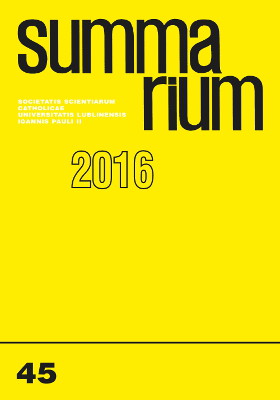

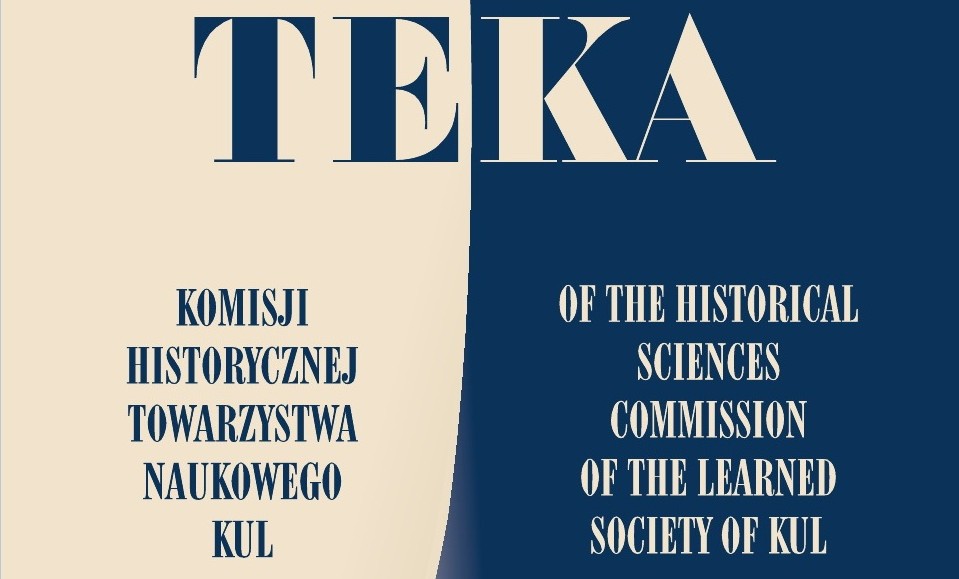
The journal “Teka Komisji Historycznej Towarzystwa Naukowego KUL“ (Teka of the Historical Sciences Commission of the Learned Society of KUL) presents the results of research on the broadly understood history of Poland and world history, both with reference to political and military issues, economic history, culture or religious organisations. Each volume has a leading theme defined by the Editorial Board, so each volume constitutes a thematic unit. "Teka Komisji Historycznej" is addressed to historians, both in Poland and those representing foreign research centres.
More...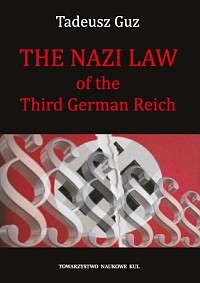
Keywords: Nazi law; Third German Reich; World War II
Although over seventy years have passed since the end of World War II, the issue of national socialism in the German Third Reich still remains the subject of scientific studies of a lot of scientists [...] and an enormous ideological challenge [...] in the process of the creation of culture fit for man as a spiritual and physical being, their natural and legal communities and – not infrequently – [...] fit for the personal Absolute. [...] A certain, maybe the shortest synthesis of the problems brought up in this thesis of the philosophy of law of the Third Reich was made – in cooperation with many Nazi scientists and politicians – by the minister of the Reich Hans Frank in the publication edited by him in 1937 Deutsches Verwaltungsrecht [...] where Justus Danckwerts states the following: “Therefore, it is the state and not the nation that stands at the beginning of analysis. The Führer is the representative of the nation. The nation acts through him. He is the highest war commander, politician, law maker, judge and administrator. Under no circumstances is he bound. Law stands above him which has been growing in the nation and has been tested in the fight of the most German members of the nation in the world of enemies and that is the reason why it is far stronger than any act of law and what is timeless. This law is the socialist national view of the world. It [meaning this view] created the deepest and the most certain foundation of the life order of the German nation. It is the fundamental law of the nation, the unwritten constitution which determines all desire and all activity, not only of the members of the German nation itself but of each person in general.” [...] It is here that, according to Rudolf Bechert, the seeming “necessity of socialism” has its reason for the systematic shaping and interpretation of law. From the Introduction
More...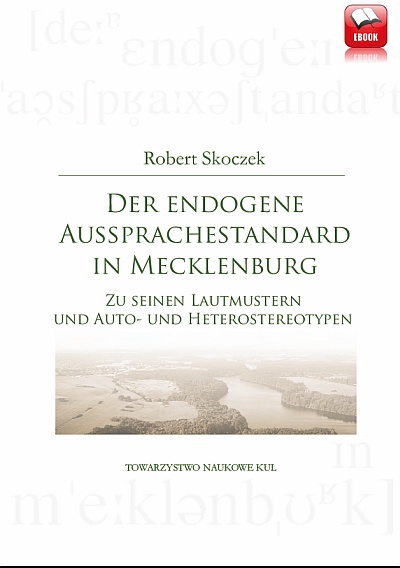
Keywords: German pronunciation; Mecklenburg; endogenous pronunciation standard
The monograph by Dr. Robert Skoczek deals with the problem of the standard German pronunciation, especially in Mecklenburg, with regard to known orthoepic reference works (Siebs, Duden, GWDA), which have a recommendable character. On the basis of a structural analysis of the German standard, the author emphasizes their heterogeneity, which in their everyday use is based both on extensive co-ordination and on the influence of elements of regional provenance. The update of the standard pronunciation was recorded in the book in a multi-faceted manner and discussed with meticulousness.From the review of Prof. em. Dr. habil. Jerzy Jeszke
More...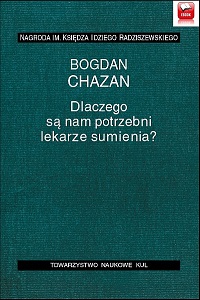
Keywords: conscience; doctor; ethics
The book is a publication of a lecture given by Prof. B. Chazan, the winner of the annual Idzi Radziszewski Award. This award is given for the whole of scientific achievements in the spirit of Christian humanities. The book contains a laudation by Rev. Prof. Dr. Habil. Józef S. Krukowski and a lecture by Prof. Dr. Habil. Bogdan Chazan on the subject: "Why do we need doctors of conscience?"
More...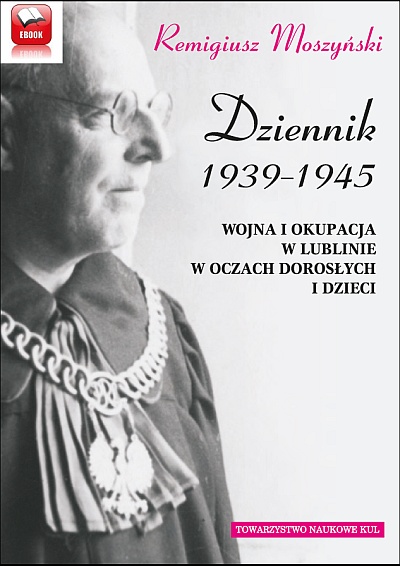
Keywords: Lublin; II World War; diary; children; occupation
Remigiusz Moszynski's diary is a new, very valuable and multifaceted scientific and cognitive historical source and at the same time has educational value. By registering and quoting Hitler and Frank's programmatic speeches, the author exposes their simple propaganda character, but also points to the to what an admonition they are to the Polish people. This heavy and dismal time has been fully shown. His reminder may have for the present generations an overtone of urgency for critical reflection on today's alternative choices.
More...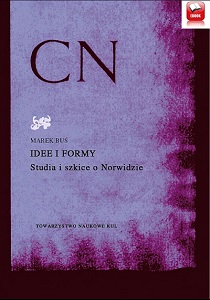
Keywords: Norwid
Marek Buś, a professor at the Pedagogical University of Cracow, is the author of the books “Składanie pieśni. Z dziejów edytorstwa twórczości Cypriana Norwida” (1997) and “Norwidyści. Miriam - Cywiński - Borowy - Makowiecki - Wyka. Konteksty” (2008), as well as a member of an editorial board of a new edition of Norwid’s works, a permanent collaborator of the “Studia Norwidiana” journal and a participant of Norwid-related conferences. The key topic of Buś’s new book boils down to the question: ‘how to read Norwid?’ Because he knows the history of Norwid’s reception he does not feel the temptation to unilaterally read, to follow interpretative trends, to expose his point of view. He believes in magnitude of the poet and in seeking traces of it in his poetry
More...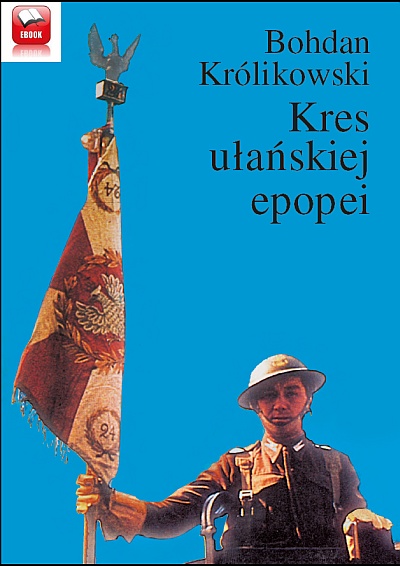
Keywords: II Warld War; Uhlans; cavalry; Armored Cavalry; Carpathian Rifle Brigade
"The end of the Uhlans’ epic" is the third part - after "The summer of Uhlans" and "The autumn of Uhlans" - a series of sketches by Bohdan Królikowski from the history of the cavalry of the Second Polish Republic. This book is a valuable and interesting item, even sensational in places. The author presents the organization and combat activities of cavalry regiments, which during the Second World War in the Polish Armed Forces in the West changed from horses to tanks and armored cars. In France (1939-1940) the cavalry formed reconnaissance units and the 10th Armored Cavalry Brigade. In the Middle East and North Africa fighters from the Carpathian Rifle Brigade organized and fought. After the fall of France, reconnaissance and armored units were created in Great Britain. Later, a cavalry was organized in the Polish Army in the USSR, and after the transition to the Middle East, reconnaissance and armored units were created. Cavalry regiments fought in Italy, northern France, Belgium, the Netherlands and Germany.
More...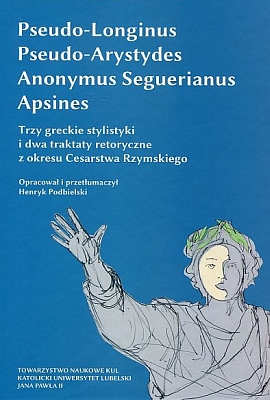
Keywords: Greek stylistic; Pseudo-Longinus; Pseudo-Arystydes; Anonymus Seguerianus; Aspines; Roman Empire
The present volume introduces Polish readers to three theories of Greek stylistics and two complete rhetorical textbooks in the spirit of the Second Sophistic which functioned in school rhetoric before Hermogenes' "Art of Rhetoric" was constituted as a canonical work. The treatise "On the Sublime" by Pseudo-Longinus is commonly perceived as the most difficult and challenging ancient text for a translator due to its depth of inquiry and reflection on the art of rhetoric combined with complex artistic form. It is worth recalling here the great role of the treatise in the shaping of Europe's modern aesthetic sensitivity which can be compared only to Aristotle's "Poetics". The huge intellectual effort and great emotional engagement of the Translator resulted in a translation which is accurate to the current state of knowledge, faithful in terms of form and content, as well as clear and meeting the readers expectation. The remaining four works have not been translated into Polish before. It is their first translation and the first comprehensive presentation in Polish, which enables wide range of recipients - interested in theoretical and practical aspects of style and public speaking - to use the works due to their scholarly analysis and historical and literary commentary.
More...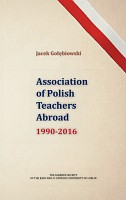
Keywords: The Association of Polish Teachers Abroad (APTA); II World War; Polonia; The United Kingdom; education
In over seventy-five years of its activity, the Association of Polish Teachers Abroad, in accordance with the Statute, has promoted Polishness in exile, and cared for preserving both the mother tongue and Polish culture. The Board has performed its duties socially, thus serving God and the homeland. A slogan “I nic nad Boga” [And nothing above God] was placed on the banner of the organization, which was solemnly consecrated on 13 October 2002. This short inscription, which is extremely rich in content, fully reflects the values that the subsequent generations of teachers of Polish Schools of Native Subjects in Great Britain have been faithful to over the years.
More...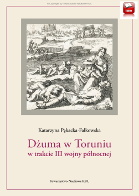
Keywords: Great Northern War; Toruń; plague
The book attempts to depict the plague in the city of Toruń (Royal Prussia) in years 1708–1711 in its entirety, and accordingly analyses the epidemic as an event which “permeates all the people of a society.” The author argues, that the plague in early modern Toruń was a total social fact and had numerous implications throughout local society, in the economic, juridical, cultural, aesthetic, political, and religious spheres, weaving together diverse strands of social and psychological life.The book consists of two main parts. The first part is descriptive and serves as a chronicle of the destructive plague that broke out in the city in 1708; it traces the ebb and flow of epidemic. Among others, the author discusses the circulation of information between collective and individual actors, and numerous activities of a magistrate of Toruń intending to control the arrival and spread of the disease and to mitigate its negative effects. Also, the mechanisms and processes of normalisation of social and individual life after the catastrophe are presented, together with the persistence of an indelible mark engraved by the disease in the collective memory of city dwellers. The first part of the book conclusively shows that the plague in Toruń in 1708–1711 permeated all spheres of social and individual life in the local community.The second, analytical part of the monograph consists of four chapters. In the first chapter, the author discusses religiosity in plague-stricken Toruń. She analyzes one of the local plague sermons from the sociological perspective to show that during the plague outbreaks religious, medical and social orders were contentiously overlapping. The sermon Christlicher Patient delivered in 1708 by Ephraim Praetorius, a devout Lutheran, was re-defining a habitual condition of a good Christian during the catastrophe and thus it was helping to guide future actions and behaviours of city dwellers simultaneously disposing them to think in a certain way about both their life and death and about charity and Christian love of neighbour. The second chapter presents the history of local plague hospitals as a complex component of urban responses to recurring epidemics. First and foremost it explains how the local lazaretto in Toruń functioned, how it was subsidized, where was it situated, who (and why) worked there, and what it was like to stay (voluntary and enforced) and die there. It also explains how the local plague fighting system was organized in the 17th and 18th centuries and how it was supported by private individuals and city offices. Consequently, the author argues that Lutheran and Catholic self-help together with new patterns of self-organisation were fundamental for specific forms of social solidarity tempore pestis. The third chapter discusses the burial of plague dead and analyzes demographic effects of the epidemic on size and composition of the city population. Among others, it specifies locations of the plague pits and plague cemeteries in Toruń in 1708–1711. It also estimates plague mortality and introduces Jacques Dupâquier’s method to detect demographic crises in the years 1700-1715 on the basis of the temporal distribution of deaths in all city parishes. The last, fourth chapter discusses an early modern phenomenon of timor pestis (fear of plague) and its components. The author argues that in the early modern period the complex notion of natural and supernatural fear was one of the most important elements of the multifaceted understanding of “pestilence” and how it spread. The numerous examples of timor pestis management taken from both ego-documents and administrative source are cited here.In the Annex to this book, editions of selected primary historical sources referring to plagues in early modern Toruń can be found.
More...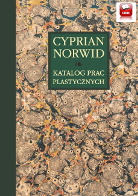
Keywords: Norwid; artistic works; Loose Works
The publication is the first complete study in the form of an academic catalogue of the artistic works by Cyprian Norwid (1821–1883), one of the most outstanding authors in the history of Polish culture. The complete, six-volume edition of the catalogue will include all that was drawn, painted or created in any other technique, that is, it includes drawings, watercolors, paintings and oil studies as well as graphic works, designs for sculptures and medallic works. Apart from the works that have been preserved, also ones that are considered lost, but were published during the artist’s life or after his death, as well as works we only know by their titles or from even minor mentions will be included.The catalogue will include both works with indisputable artistic value and rough sketches like notes in the form of drawings; and also, apart from loose compositions – works drawn on pages of sketchbooks and albums; moreover, drawings that are found in Norwid’s artistic and journalistic texts, in his letters and notes.Volume Four of the catalogue contains the second part of the section: Loose Works, comprising Norwid’s sketches and watercolors painted in the years 1858–1883. Each catalogue item contains complete information on the work, along with its complete bibliography and a color illustration.
More...